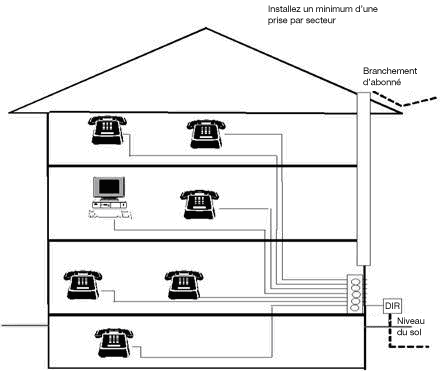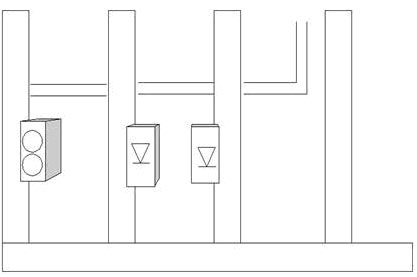Support for Telephone service
Inside Wiring
New installation
What is pre wiring?
Pre wiring is the method of installing telephone cabling so that it is concealed within the interior partition walls of your premises. Pre wiring is done in the framing (or hollow frame) stage at the same time as the electrical wiring, and before the application of insulation, drywall, and vapour barrier. Once the walls have been surfaced, wiring cannot be removed or replaced without disturbing the wall.
Télébec recommends that conduit be placed when installing inside wiring in your premises. Conduit provides you with greater flexibility when moving and/or repairing inside wiring after walls have been surfaced.
What do you need to do to pre wire your premises?
Follow these steps:
1. Select locations to suit both your present, and future, telecommunications needs.
Diagram # 2
It is not necessary to have a telephone connected at every pre wire location. Installing a flexible system at the pre wiring stage means that you won't have to add unsightly surface wiring or cope with inadequate facilities in the future. Consider the possibility of putting in a second line, fax line, or a modem line for the Internet. Security wiring and cable television should also be planned at this time. Tomorrow's technologies may place additional demands on your pre wiring. Plan for it now.
2. Plan the cable route within your premises
To avoid possible damage from future construction, rubbing, overheating, dampness, or contact with power wires, carefully plan the route within your premises. The route should follow a supported path through floor joists, over ceilings, through wall studs, and behind baseboards. The route you select should conceal the cable. A separate telephone cable to each jack outlet from the main terminal location is required. The separate runs allow for ease of movement and arrangement of your telephone services (lines) and allow sufficient cable pairs for maintenance.
NOTE:
1. Don't run wiring parallel to power cables within the same stud or joist space, otherwise transmission problems may be experienced.
2. Don't pull telephone cables through holes occupied by electrical cables.
3. Don't locate the telephone outlet between the same studs as a power outlet.
Diagram # 3
3. Ensure that your inside wiring meets standards.
Telecommunications wiring should meet all local and Canadian Electrical Code Standards. Télébec recommends the inside wire cable be a minimum four pair twisted 24 AWG solid annealed copper. This cable will ensure better transmission quality and will meet voice and data requirements. Don't use flat wire such as telephone set line cord or lamp wire for pre wiring, as it can cause transmission problems.
4. Install the Inside wiring and jacks.
Fix a type 1104 electrical outlet box to a stud at each location where a telephone jack may be required. These boxes should be at least 30 cm (12") above the floor. Then run an individual telephone cable to your wiring terminal block. Keep cable runs unbroken between jack locations and the terminal room. Leave at least 30 cm (12") of excess cable at both ends for ease of connection. Although it is tempting to splice two shorter lengths together to economize on cable costs, doing so can cause interference on your telephone line and will have a high potential as a future trouble spot.
5. Install a terminal block.
For ease of maintenance, Télébec recommends that you terminate all wire from the demarcation block on a terminal block. The terminal block is used to connect common wires from each cable run. The terminal block should be located on the backboard in your mechanical or electrical room so that the inside wires can be easily attached to the demarcation block.
6. Connect the Inside wiring to the demarcation block.
For each telephone service (number), run one pair of wires from your terminal block into the demarcation block. Télébec maintains the demarcation block, which is inside the Network Interface Device (NID) enclosure. The NID enclosure is mounted on the outside walls of your dwelling usually near the electrical meter. To gain access to the NID enclosure and the demarcation blocks, loosen the screw located in the middle of the NID enclosure. The screw terminals on the demarcation blocks will be one of two colours:
Green (tip side of the line)
Red (ring side of the line)
The standard demarcation block consists of a universal jack and termination screws for inside wire. Only one pair (two wires) is to be terminated on the demarcation jack for each service (telephone number) requested.
7. Test the cable and jacks once Télébec has provided service to the demarcation point.
Each jack should be checked as follows:
1. Plug in a telephone set, lift the handset and listen for a dial tone. If you hear a dial tone, proceed to step #3. If you don't hear a dial tone, proceed to step #2.
2. Ensure that all wire connections are secure. Try a different phone set to ensure the first set is not defective. If a dial tone is still not heard or you hear excessive noise, test the line at the demarcation jack in the Network Interface Device on the outside of your premises. Remove the plug at the demarcation jack and attach a standard telephone set. If you don't hear a dial tone or if excessive noise continues, call Télébec at 611. If your house is not equipped with a Network Interface Device and none of your jacks have dial tone, call Télébec at 611.
3. Dial a digit and listen: the dial tone should stop and the line should be quiet. If you hear excessive noise alter dialing, go back to step #2.
4. If you have two lines, try calling from one line to the other.
Note: If the trouble is diagnosed as being in the customer-owned inside wire, a service charge will be applied.

 rough holes occupied by electrical cables.
rough holes occupied by electrical cables.